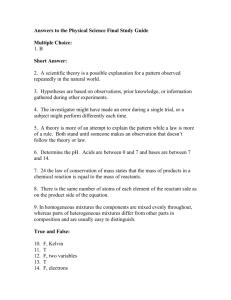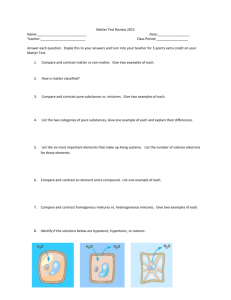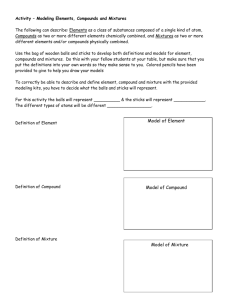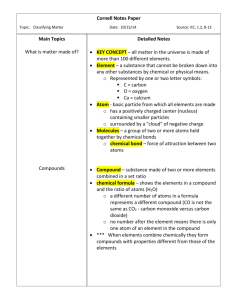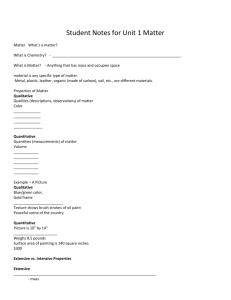PPT 1 - Teach.Chem
advertisement
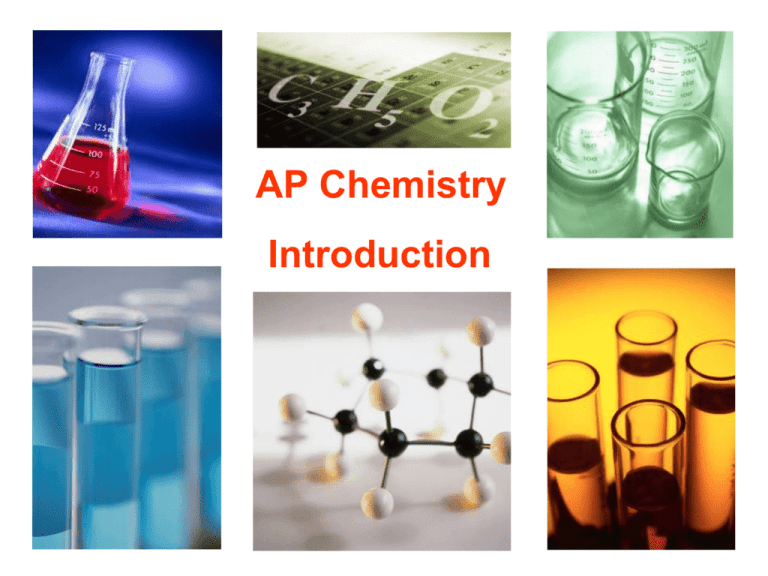
AP Chemistry Introduction matter: anything having mass and volume mass: the amount of matter in an object weight: the pull of gravity on an object volume: the space an object occupies units: L, dm3, mL, cm3 conversions: 1 L = 1 dm3; 1 mL = 1 cm3 state of matter: solid, liquid, or gas atom: a basic building block of matter -- ~100 diff. kinds Broken Dreams Blvd. Elements contain only one type of atom. (a) monatomic elements consist of “unbonded,” identical atoms e.g., Fe, Al, Cu, He (b) polyatomic elements consist of several identical atoms bonded together -- diatomic elements: H2 O2 Br2 F2 I2 N2 Cl2 -- others: P4 S8 “7 7 7” (c) allotropes: different forms of the same element in the same state of matter OXYGEN CARBON oxygen gas (O2) elemental carbon graphite diamond buckyball ozone (O3) molecule: a neutral group of bonded atoms Description Chemical Symbol 1 oxygen atom O 1 oxygen molecule O2 2 unbonded oxygen atoms 2O 1 phosphorus atom P 1 phosphorus molecule P4 4 unbonded phosphorus atoms 4P Model Elements may consist of… either molecules or unbonded atoms. 2 Chemical symbols for elements appear on the periodic table; only the first letter is capitalized. He 4.003 10 Ne 20.180 18 Ar 39.948 36 Kr 83.80 54 Xe 131.29 86 Rn (222) Compounds contain two or more different types of atoms. -- have properties that differ from those of their constituent elements table salt (NaCl) e.g., Na (sodium): explodes in water Cl2 (chlorine): poisonous gas Compound Composition All samples of a given compound have the same composition by mass. Every sample of NaCl tastes the same, melts at the same temp., and is 39.3% Na and 60.7% Cl by mass. A 550. g sample of chromium(III) oxide (Cr2O3) has 376 g Cr. How many grams of Cr and O are in a 212 g sample of Cr2O3? 376 g Cr % Cr = 550 g 68.4% Cr and 31.6% O (New sample has same composition.) Cr: 212 g (0.684) = 145 g Cr O: 212 g (0.316) = 67 g O chromium(III) oxide composition: what the matter is made of copper: many Cu atoms water: many “threesomes” of 2 H’s and 1 O Properties describe the matter. e.g., what it looks like, smells like, how it behaves Chemistry tries to relate the microscopic and macroscopic worlds. States of Matter SOLID (( (( (( (( (( ))(( ))(( ))(( ))(( ))(( ))(( ))(( ))(( ))(( ))(( vibrating LIQUID GAS )) )) )) )) )) translating; close together translating quickly; far apart vapor: the gaseous state of a substance that generally is found as a solid or liquid Changes in State Energy put into system: sublimation melting SOLID boiling LIQUID freezing condensation deposition Energy removed from system: GAS Classifying Matter (Pure) Substances have a fixed composition and fixed properties. -- they have a single chemical formula ELEMENTS COMPOUNDS e.g., Fe, N2, S8, U e.g., H2O, NaCl, HNO3 sulfur (S8) sodium chloride (NaCl) Mixtures contain two or more substances mixed together. -- have varying composition and varying properties -- The substances are NOT chemically bonded; they retain their individual properties. Tea, orange juice, oceans, and air are mixtures. Two Types of Mixtures homogeneous: (or solution) sample has same composition and properties throughout; evenly mixed at the particle level e.g., salt water Kool Aid alloy: a homogeneous mixture of metals e.g., bronze (Cu + Sn) pewter (Pb + Sn) brass (Cu + Zn) Two Types of Mixtures (cont.) heterogeneous: different composition and properties in the same sample; unevenly mixed tossed salad e.g., raisin bran suspension: settles over time e.g., paint snow globes Chart for Classifying Matter MATTER PURE SUBSTANCE ELEMENT MIXTURE COMPOUND HETEROGENEOUS HOMOGENEOUS Separating Mixtures -- No chemical reactions are needed because… involves substances are NOT bonded. physical means, or physical changes. 1. sorting: by color, shape, texture, etc. 2. filtration: by particle size Separating Mixtures (cont.) 3. magnetism: one substance must contain iron 4. chromatography: some substances dissolve more easily than others Separating Mixtures (cont.) 5. density: “sink vs. float”; perhaps use a centrifuge blood after highspeed centrifuging decant: to pour off the liquid Separating Mixtures (cont.) 6. distillation: different boiling points thermometer water out (warmer) water in (cooler) more-volatile substance (i.e., the one with the lower boiling point) mixture more-volatile substance, now condensed heat source Volatile substances evaporate easily.
